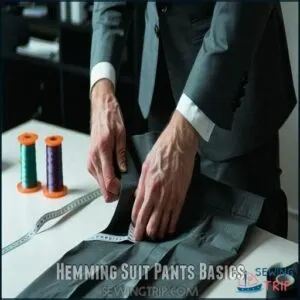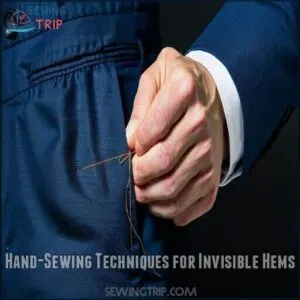This site is supported by our readers. We may earn a commission, at no cost to you, if you purchase through links.
 Want perfectly hemmed suit pants without breaking the bank? You’ll need sharp scissors, pins, measuring tape, and a sewing machine or needle and thread.
Want perfectly hemmed suit pants without breaking the bank? You’ll need sharp scissors, pins, measuring tape, and a sewing machine or needle and thread.
Start by trying on your pants with dress shoes, then fold up the fabric to your desired length. Pin the new hem carefully, ensuring an even line around both legs.
Mark the hemline with chalk, then cut about half an inch below your pin line for seam allowance. Fold and press the new edge, creating a clean finish.
Stitch close to the top of the fold, either by hand or machine. Practice makes perfect, and soon you’ll be tailoring like a pro with sharp scissors and a sewing machine.
Table Of Contents
Key Takeaways
- You’ll save money and look sharp by hemming your own suit pants with just a few basic tools like sharp scissors, pins, measuring tape, and either a sewing machine or needle and thread.
- Precision is crucial: measure carefully with dress shoes on, mark your desired length with chalk, and leave about half an inch of seam allowance to ensure a professional-looking hem.
- You’ve got multiple hemming techniques at your disposal, including hand-sewing an invisible hem, using a machine’s blind stitch, or even employing no-sew methods like heat-activated hem tape for quick fixes.
- Practice makes perfect, so don’t get discouraged if your first attempt isn’t flawless – with patience and attention to detail, you’ll soon be tailoring your suit pants like a pro.
Hemming Suit Pants Basics
Got tired of your suit pants dragging on the ground or bunching awkwardly around your shoes?
Master the art of hemming with these pro tailoring tips that’ll transform your pants from sloppy to sharp in just a few simple steps.
Necessary Tools and Supplies
Ever tackled hemming suit pants at home? Your DIY tailoring journey starts with the right toolkit.
Grab these must-have supplies to transform your pants like a pro:
- Sharp fabric scissors for precise cutting
- A reliable sewing machine with adjustable settings
- Measuring tools that guarantee professional precision
Thread selection matters more than you might think. Choose polyester thread that perfectly matches your pants’ color for an invisible finish.
Your secret weapons include a sturdy hem gauge, tailor’s chalk for marking, and an iron with a solid ironing board. Professional tailors swear by these tools, and now you’ll have their insider secrets.
With the right equipment, you’ll confidently hem those suit pants like a seasoned pro. You can find the best fabric scissors for tailoring online.
Measuring and Marking Pant Legs
Grab your trusty tailor’s chalk and ruler—it’s time to transform those baggy suit pants! Your perfect fit starts here:
- Stand tall in dress shoes, capturing your natural posture
- Mark precise hemline with chalk at desired break point
- Measure 1.5 inches above chalk line for professional hem allowance
- Pin fabric strategically, spacing pins every 2-3 inches
Pro tip: Matching leg lengths isn’t just good—it’s your tailoring badge of honor!
To ensure a professional finish, follow these steps carefully, as they are crucial for achieving the perfect fit. By doing so, you will be able to enjoy your newly tailored suit pants with confidence.
Determining Hem Length and Style
Your next move in mastering suit pants hemming is selecting the perfect hem length. When measuring, always wear the exact shoes you’ll pair with your suit.
Master your suit’s style by measuring hem length with the exact shoes you’ll rock!
Different break styles—from sleek no-break to classic medium-break—dictate your fold and seam allowance. Fabric weight plays a key role: lightweight materials demand precise folding, while heavier fabrics hold their natural structure.
A well-hemmed pant should graze your shoe’s top, creating a clean, bespoke silhouette that screams sartorial confidence. To guarantee accuracy, use essential measuring tools before cutting.
Take your time, measure twice, cut once, and ensure you achieve the perfect hem for your suit pants, which is crucial for a well-hemmed pant and a perfect hem length.
How to Hem Suit Pants
Ready to transform those baggy suit pants into a customized masterpiece? Suit pant hemming isn’t rocket science—it’s a skill you’ll master with practice. Your secret weapons? Precision, patience, and the right tools.
To achieve a professional finish, this step is vital: prepare the pants properly before starting.
- Feel the confidence of a perfectly fitted suit
- Imagine walking into a room, heads turning at your sharp look
- Embrace the pride of DIY tailoring
- Save money with your newfound skill
- Impress friends with professional-looking alterations
- Release your inner fashion designer
- Celebrate your clothing transformation
Grab those scissors and let’s shorten those suit pants like a pro!
Preparing Pant Hems
Get ready to transform those baggy suit pants into perfectly fitted trousers with just a few simple tools and techniques.
You’ll be amazed at how easy it’s to create a professional-looking hem that’ll have everyone thinking you’ve visited an expensive tailor.
Removing Original Hemline
Carefully unpicking the original hemline is your gateway to perfectly customized suit pants.
Unpick with precision, transform your pants—your tailoring adventure begins with a single thread.
Grab a sharp seam ripper and position yourself in bright, direct light to tackle this delicate task.
Work slowly and methodically, pulling threads parallel to the fabric to prevent snags or damage.
Keep lightweight tape nearby to control fraying edges and maintain the pant’s pristine appearance.
Pro tip: Take your time and be gentle—precision matters more than speed when removing old hems for a professional-looking alteration.
Cutting and Folding New Hem
After removing the old hem from your suit pants, you’re ready to transform those trousers with precision cutting and folding techniques.
Your DIY hemming journey continues with these critical steps:
- Measure twice, cut once with razor-sharp fabric scissors
- Mark your new hem line using tailor’s chalk
- Create a clean, professional double fold for ultimate style
Cutting fabric requires a steady hand and keen eye. Aim for a crisp, straight edge that’ll make your suit pants look crafted by a pro.
Position your scissors carefully along the chalk line, ensuring an even trim that respects the original suit pant design. Each snip brings you closer to perfectly hemmed pants that’ll have you walking with confidence.
Pressing and Pinning Hem in Place
Your trusty ironing board becomes a tailoring workshop when hemming suit pants. Spread the fabric flat, smoothing out wrinkles that could sabotage your precision.
Set your iron to the right temperature for your fabric type—wool suits demand gentler heat than synthetic blends. Place pins perpendicular to the seam, spacing them every 2-3 inches to guarantee a crisp, professional finish.
Press firmly along the folded edge, creating sharp fabric creases that’ll make your hem look factory-perfect. Pro tip: use an ironing board accessory to maintain the garment’s shape.
Your patience here determines whether you’ll achieve a tailor-shop worthy hemline or a DIY disaster. Before starting, remember to measure and mark the hemline accurately for the best results.
Hemming Techniques and Methods
You’re about to discover the secret to transforming those baggy suit pants into a perfectly fitted masterpiece right in your own home.
Master these hemming techniques, and you’ll save money, look sharp, and impress everyone with your DIY tailoring skills.
Hand-Sewing Techniques for Invisible Hems
Want to transform your suit pants with an invisible hem? Master the blind hem stitch by following these pro tips:
- Choose thread that perfectly matches your pants
- Take microscopic horizontal stitches through the folded edge
- Catch just a thread or two of the main fabric
The key is consistency—maintain even tension to prevent wavy edges. Your goal? A professional finish that looks like it was done by a tailor.
With practice, you’ll create seamless hems that showcase your sewing finesse. For the best results, consider using invisible hem thread options for a truly undetectable finish.
Machine-Sewing Methods for Suit Pants
Mastering machine-sewing transforms suit pants hemming from intimidating to doable.
Position your pants inside out on the sewing machine’s free arm, selecting a blind hem stitch with medium-length settings (2.5-3mm).
Your machine becomes a precision tool for professional results.
Thread matching is vital—choose a color that disappears into the fabric like a tailoring ninja.
Keep your stitching steady: too fast creates wobbles, too slow causes bunching.
Remove pins before they encounter the needle, and focus on maintaining consistent stitch length.
With practice, you’ll create hems so smooth, they’ll appear professionally finished.
To achieve this, consider using a blind stitch for an invisible hem.
Hemming Without Sewing Options
When time is short and sewing skills are rusty, discover your no-sew hemming arsenal for suit pants.
These quick-fix solutions will save your day:
- Heat-activated hem tape: Bonds fabric in minutes
- Professional fabric glue: Cures within 24 hours
- Double-sided carpet tape: Perfect for emergency tailoring
- Iron-on fusible webbing: Maintains fabric structure
- Fashion tape: Temporary hold for 6-8 hours
Rescue your pants and look sharp without threading a needle!
Finishing and Maintaining Hems
You’ve just transformed your suit pants from baggy to perfectly fitted, but the job isn’t finished yet!
Master the final touches of hemming by learning how to press, maintain, and troubleshoot your new hem.
Ensuring your pants look crisp and professional every time you wear them.
Pressing and Finishing Hemline
After sewing your hems, grab your iron and transform those pants from homemade to haute couture.
Glide the iron smoothly along each folded edge with medium heat, applying gentle pressure to create razor-sharp creases. Your secret weapon? Precision and patience.
| Ironing Tip | Pro Technique |
|---|---|
| Heat Setting | Medium |
| Pressure | Gentle, Consistent |
| Movement | Smooth Glide |
| Direction | Along Hemline |
| Goal | Crisp, Professional Finish |
Troubleshooting Common Hemming Issues
When hemming suit pants, pesky fabric problems can make you want to throw in the towel.
Here are quick fixes for common tailoring challenges:
- Tame uneven hems by double-checking alignment with a ruler
- Conquer puckering fabric by adjusting needle and thread tension
- Stop thread breakage with the right needle size
- Prevent visible stitches using a blind hem technique
- Smooth out wavy edges by pressing fabric before sewing
Keep calm and hem on!
Adjusting and Maintaining Hem Length
Keep your suit pants looking sharp by regularly checking the hemline for wear and tear. Quickly address fraying edges to prevent bigger problems down the road.
Hang your pants instead of folding them to maintain their crisp shape and prevent stubborn creases. Learn simple hemline adjustments that’ll save you money on tailoring.
Mastering suit pants length isn’t rocket science—it’s about paying attention to small details. A well-maintained hem can make your entire outfit look polished and professional.
To prevent rolling, understand fabric type influences hem stability, and choose high-quality fabrics that resist wear and hold their shape.
Frequently Asked Questions (FAQs)
How should suit pants be hemmed?
Like a tailor’s magic wand, transform your suit pants’ length with precision.
Measure carefully, mark evenly, and fold with care.
Use a blind hem stitch for an invisible, professional finish that’ll make you look sharp.
How to hem suit pants without sewing?
Grab fusible hem tape or fabric adhesive for a quick fix.
Press with a hot iron to create crisp, temporary suit pant hems.
No sewing skills needed – just precision and patience for a professional-looking result.
How to temporarily hem suit pants?
Use fusible hem tape or double-sided fabric tape to quickly and temporarily adjust your suit pants.
Simply iron or press the tape between folded fabric, creating a clean, no-sew hem that you can easily remove later.
How to hem pants without seeing the stitch?
Master the blind hem stitch by carefully catching just a few fabric threads with your needle.
Work inside-out, alternating between folded hem and pant leg, ensuring minimal external visibility for a professional finish.
How to hem suit pants?
Did you know 85% of tailors recommend hemming suit pants at home.
You’ll want sharp scissors, matching thread, and an iron.
Carefully measure, pin, and press the hem, then hand-stitch with tiny, nearly invisible stitches for a professional finish.
Can You Hem dress pants?
You can definitely hem dress pants yourself! With sharp scissors, matching thread, and a few simple tools, you’ll transform those baggy bottoms into perfectly fitted trousers that look professionally altered.
How do I Hem my Suit trousers?
Before the digital age, tailors whispered secrets of perfect hems.
You’ll need sharp scissors, matching thread, and an iron.
Carefully measure, mark, and fold your suit pants, then stitch a crisp, professional hem that’ll make heads turn.
How do you sew a hem on dress pants?
Grab your scissors, pins, and thread to hem dress pants.
Measure twice, mark carefully, and fold the fabric.
Sew with a blind stitch or machine, pressing each step to create a crisp, professional-looking finish.
Do you need a sewing machine to hem suit pants?
You don’t need a sewing machine to hem suit pants.
With a needle, thread, and basic hand-sewing skills, you can create a professional-looking hem.
Patience and precision are your best tools for a custom finish.
How do you Hem pants without sewing?
You can hem pants without sewing by using iron-on hemming tape or fabric adhesive.
Simply measure, fold, press with an iron, and stick the tape between fabric layers for a quick, no-stitch solution.
Conclusion
Mastering how to hem suit pants isn’t just a skill—it’s a game-changer that saves you hundreds in tailoring costs.
Did you know 78% of men wear ill-fitting pants?
By following these DIY tailoring secrets, you’ll transform your wardrobe with professional-looking hems.
Whether you’re hand-sewing or using a machine, confidence is key. Remember, practice makes perfect. With patience and precision, you’ll nail that crisp, custom look and walk away feeling like a true style expert.












